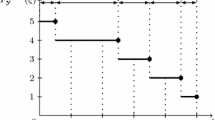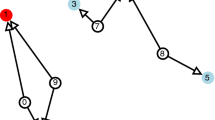Abstract
Many location problems can be expressed as ordered median objective. In this paper, we investigate the ordered median objective when the demand points are generated in a circle. We find the mean and variance of the kth distance from the centre of the circle and the correlation matrix between all pairs of ordered distances. By applying these values, we calculate the mean and variance of any ordered median objective and the correlation coefficient between two ordered median objectives. The usefulness of the results is demonstrated by calculating various probabilities such as: What is the probability that the mean distance is greater than the truncated mean distance? What is the probability that the maximum distance is greater than 0.9? What is the probability that the range of distances is greater than 0.8? An analysis of an illustrative example also demonstrates the usefulness of the analysis.

Similar content being viewed by others
References
Abramowitz M and Stegun IA (1972). Handbook of Mathematical Functions. Dover Publications: New York, NY.
Altınel IK, Durmaz E, Aras N and Özkısacık KC (2009). A location-allocation heuristic for the capacitated multi-facility Weber problem with probabilistic customer locations. European Journal of Operational Research 198: 790–799.
Arnold BC, Balakrishnan N and Nagaraja HN (1992). A First Course in Order Statistics. John Wiley & Sons: New York, NY.
Averbakh I and Bereg S (2005). Facility location problems with uncertainty on the plane. Discrete Optimizatiion 2: 3–34.
Berman O, Drezner Z and Wesolowsky GO (2003). The expropriation location problem. Journal of the Operational Research Society 54: 769–776.
Beyer HW (1981). Standard Mathematical Tables. CRC Press: Boca Raton, Florida.
Cooper L (1974). A random location equilibrium problem. Journal of Regional Science 14: 47–54.
Drezner T, Drezner Z and Guyse J (2009). Equitable service by a facility: Minimizing the Gini coefficient. Computers and Operational Research 36: 3240–3246.
Drezner Z (1992). Computation of the multivariate normal integral. ACM Transactions on Mathematical Software 18: 470–480.
Drezner Z (1994). Computation of the trivariate normal integral. Mathematics of Computation 62: 289–294.
Drezner Z (2007). A general global optimization approach for solving location problems in the plane. Journal of Global Optimization 37: 305–319.
Drezner Z and Nickel S (2009a). Solving the ordered one-median problem in the plane. European Journal of Operational Research 195: 46–61.
Drezner Z and Nickel S (2009b). Constructing a DC decomposition for ordered median problems. Journal of Global Optimization 45: 187–201.
Drezner Z and Simchi-Levi D (1992). Asymptotic behavior of the Weber location problem on the plane. Annals of Operations Research 40: 163–172.
Drezner Z and Suzuki A (2004). The big triangle small triangle method for the solution of non-convex facility location problems. Operations Research 52: 128–135.
Drezner Z and Wesolowsky GO (1981). Optimum location probabilities in the l p distance Weber problem. Transportation Science 15: 85–97.
Drezner Z and Wesolowsky GO (1990). On the computation of the bivariate normal integral. Journal of Statistical Computation and Simulation 35: 101–107.
Drezner Z, Klamroth K, Schöbel A and Wesolowsky GO (2002). The weber problem. In: Drezner Z and Hamacher HW (eds) Facility Location: Applications and Theory. Springer: Berlin, pp 1–36.
Durmaz E, Aras N and Altınel IK (2009). Discrete approximation heuristics for the capacitated continuous location-allocation problem with probabilistic customer locations. Computers and Operations Research 36: 2139–2148.
Frank H (1966). Optimum locations on a graph with probabilistic demands. Operations Research 14: 409–421.
Frank H (1967). Optimum locations on graphs with correlated normal demands. Operations Research 15: 552–557.
Gradshteyn LS, Ryzhik IM and Jeffrey A (1994). Tables of Integrals, Series, and Products. 5th edn, Academic Press: San Diego, CA.
Horst R and Thoai NV (1999). DC programming: Overview. Journal of Optimization Theory and Applications 103: 1–43.
Johnson NL and Kotz S (1972). Distributions in Statistics: Continuous Multivariate Distributions. Wiley: New York.
Kalcsics J, Nickel S, Puerto J and Tamir A (2002). Algorithmic results for ordered median problems. Operations Research Letters 30: 149–158.
Love RF, Morris JG and Wesolowsky GO (1988). Facilities Location: Models & Methods. Elsevier Science, North Holland: New York, NY.
Melo MT, Nickel S and Saldanha-da-Gama F (2009). Facility location and supply chain management—A review. European Journal of Operational Research 196: 401–412.
Murat A, Verter V and Laporte G (2010). A continuous analysis framework for the solution of location-allocation problems with dense demand. Computers and Operations Research 37: 123–136.
Nickel S and Puerto J (2005). Facility Location—A Unified Approach. Springer: Berlin Heidelberg.
Rodríguez-Chía AM, Nickel S, Puerto J and Fernandez FR (2000). A flexible approach to location problems. Mathematical Methods of Operations Research 51: 69–89.
Snyder LV (2006). Facility location under uncertainty: A review. IIE Transactions 38: 547–564.
Weber A (1929). Über den Standort der Industrien, 1. Teil: Reine Theorie des Standortes. English Translation: On the Location of Industries. University of Chicago Press: Chicago, IL, Originally published in Tuobingen, Germany in 1909.
Wesolowsky GO (1977a). The Weber problem with rectangular distances and randomly distributed destinations. Journal of Regional Science 17: 53–60.
Wesolowsky GO (1977b). Probabilistic weights in the one-dimensional facility location problem. Management Science 24: 224–229.
Author information
Authors and Affiliations
Appendix
Appendix
Proofs
Proof of Theorem 1

Substituting m=j−1 in the first sum and recalling that  leads to:
leads to:

All the terms, except the first one in the first sum, cancel out proving the Theorem.
Proof of Lemma 3
For simplicity of presentation, let  . By Formula (5.2.3) in Arnold et al (1992).
. By Formula (5.2.3) in Arnold et al (1992).

Equation (15) is therefore by isolating all the terms that include p and applying Lemma 2:

Similarly to the derivation of Lemma 2,  . Hence,
. Hence,

Yielding,

In obtaining Equation (16), we assume that j>i. However, the formula is correct also for j=i: μ ii =i/(n+1), which is the same as E i 2 by the proof of Theorem 4.
Rights and permissions
About this article
Cite this article
Drezner, Z., Nickel, S. & Ziegler, HP. Stochastic analysis of ordered median problems. J Oper Res Soc 63, 1578–1588 (2012). https://doi.org/10.1057/jors.2012.2
Received:
Accepted:
Published:
Issue Date:
DOI: https://doi.org/10.1057/jors.2012.2




